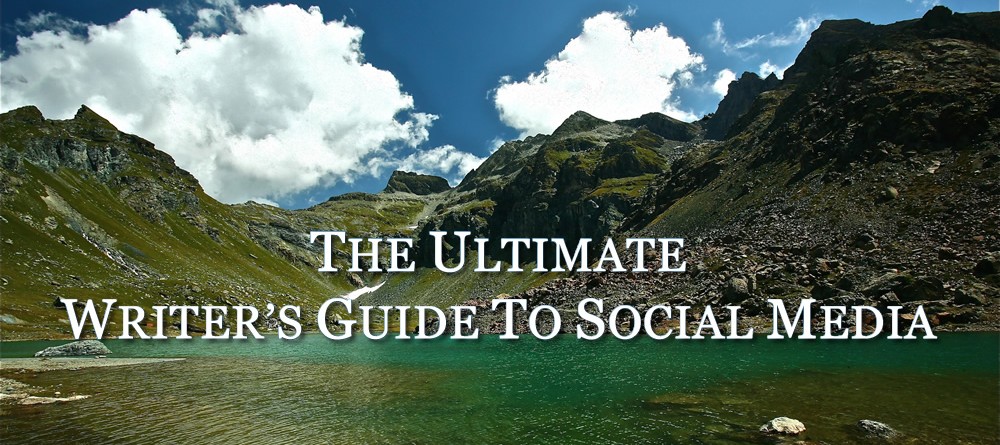Recently I’ve come to understanding that some people here, on the Internet, still lack the profound understanding of what the laws of professional writing allow and don’t allow to do. Even the most experienced writers from the best writing services can once for a while repeat the same mistake—what are the chances for some newbie content maker?
Note from Nick: this post originally appeared on LiveHacked.com in early 2012; I’m re-publishing it here because 1) it’s one of my favorite posts and 2) after the major server migration I just finished this past weekend, I didn’t have it in me to write something new before this morning! Enjoy!
Social Media: The Ultimate Guide for Writers
I’ve been thinking and reading a lot about social media lately, and specifically how it should (and shouldn’t) be used by writers. By writers, I mean “creators;” creators of fiction thriller novels, non-fiction ebooks and guides, or bloggers, or anything in-between.
Writers usually understand that they need social media, but they don’t understand that they really need social media to work for them.Before I jump in, I want to clarify–I’m not a fan of “big promise, small delivery” kinds of content. This post has a powerful headline, and I intend to follow through with that. The reason I feel confident enough to write this article is that I’ve actually seen the effects of good social media use and bad social media use.
If you didn’t know, I used to run a marketing firm. We normally built marketing campaigns around custom websites for our clients, and when “social media” hit it big, we jumped on board.
We made a lot of mistakes.
We learned how to run a successful newsletter campaign, and we knew how to build effective Facebook and Twitter accounts, and we were able to make them look good.
Our clients were able to make money doing what they loved, while we handled most of the nitty-gritty details of social media.
But you probably don’t have a firm to handle that stuff for you (and, unfortunately for both of us, we no longer manage campaigns).
So, I thought I’d write what we found over the course of the six or so years we did what we did. This article is going to be long, and it’s going to be in-depth. If you don’t really want to learn specific, actionable tactics and strategies we found or developed, then this post ISN’T FOR YOU.
But, if you’re in the place where you do want to learn about how to use social media to your advantage, read on.
Social Media is NOT a Networking Event

There’s something about Twitter that’s always bugged me. It’s a great platform, don’t get me wrong, but it seems like so many people treat it like it’s a gigantic networking event.
You know the type–slick salesmen walking around throwing their business cards at people like ninja stars, and forty thousand Avon or Sensy candle reps trying to get your attention.
Sometimes people treat Twitter like that as well. For those of you who think Twitter exists solely to slam your wares down other people’s throats, let me be clear:
Stop.
If that kind of behavior frustrates and alienates people at “real” networking events (where that kind of stuff is almost expected) don’t you think it’s going to frustrate and alienate people online, as well?
Instead, use Twitter to add value to the conversation. More on this later.
You should have a Twitter account–pretty much any industry or business model can benefit from social media. Don’t believe me? Ask me about my client in the mortgage industry who sold abstracting and document-retrieval services to county records offices. Yeah.
So, while you already know that you need to add value to the conversation, what does that look like? Or, rather, how do you add value to Twitter?
Three Ways to Add Value To Twitter Conversations
- Connect like-minded people. Take an hour, once a week, and focus on trying to connect people in your network (your followers) to others in your network: “Hey, Jim, I just remembered–I have a really awesome social guy in my network you should reach out to. I know you were looking for some help there!”
- Create lists and organize your account. Obviously, in order to connect people to one another, you’ll need to really get to know your followers. This takes intense focus on keeping up with your Twitter account. You can use lists through Twitter.com, or (my preference) TweetDeck, where you can manage at-a-glance your different lists and connections. Spend a few hours (or more) organizing your “Tweeps” into areas of interest, industry, or field of expertise. Once you do this, it’s amazingly easy to see which of your connections are the most helpful, and which ones are basically Spambots.
- Use the 80/20 rule. 80% of the time you should be retweeting others, posting content from other people (preferably from your own connections’ resources!), and linking to other people’s websites and blogs. The other 20% of the time, you can “self-promote.” I often end up doing about 90/10, with a mix of non-self-promotion-yet-still-personal Tweets thrown in to keep it real, but most of my RTs and links to outbound content is automated in some way (so that I don’t have to actively manage it constantly). More on that later, too.
So, again–don’t use Twitter like it’s a networking event. Treat it like a reunion; a group of extended friends who haven’t seen each other in years, and you want to brag about your own connections’ accomplishments first, and then your own.

Facebook Isn’t Just for Friends Anymore.
There was a time when Facebook was a sacred place; for friendships only. Thankfully, it still has a “friendly” atmosphere, but it’s also grown up a bit. If you don’t have an author page (if you’re a book writer) or a business page (if you’re a business), you should definitely go set one up.
Facebook pages are great for keeping true fans up-to-date on your whereabouts, goings-on, and other smashed-together words that almost make sense.
BUT:
- Only use Facebook Pages if you’re going to use them. This sounds pretty obvious (and it’s a truism for all of social media, I might add), but it’s pretty sad when I come across a well-designed Facebook page, enticing me to click the “Like” button to get something free and awesome, and then I don’t find anything helpful or relevant or “value-adding” after. Fill it out with helpful, value-adding content that they’ll enjoy. Your “fans” want you (or your brand) to speak to them on their terms, not on yours. Use the page to promote your work; sure. But also use it ask your fans WHY they’re your fans in the first place–Facebook is the type of platform that beckons people to share their personal insights and lives much more, and you can capitalize on that through your page.
- Don’t take the same approach as Twitter. To put it bluntly, it’s not Twitter. Ask questions, run polls, interact with your fans in a way not related to your own brand every once in a while, and use the feedback to become more human; more personal to them.
- Ask your fans to find more fans, but not too often. Facebook is an odd beast–it’s the only social network (that I’ve found, so far) made up of people who seem to not mind promoting something good when prompted. By this, I mean that if you were to ask your Twitter followers to ask their followers to follow you, they would just get confused (like you just did, trying to follow that sentence). On Facebook, though, you can–with little incentive–ask your fans to share your page with their friends and family to help get your name out there.
The reason for this is that it’s a platform built on friendship in real life, and then online. If I “Like” something on Facebook, it’s usually because it’s either really good, something I wouldn’t mind showing to my pastor/mom/wife/boss, or it’s special enough to share anyway. So, you can ask them to take the next logical step:
“Hey fans, I’d really like to try to get my book into as many hands as possible when it launches–if you can, I’d love for you to share this page with those in your network who would appreciate and enjoy it! Thank again for your support!”
That sentence doesn’t come across too spammy on Facebook most of the time (you STILL have to be cognisant and mindful of what you’re pushing) because most of the people who are your fans in the first place are going to appreciate what you do, want to help, and feel a desire to be a part of your success.
Social Media Isn’t Just About “Social” Sites.
Social media now encompasses everything from your age-old LiveJournal account that still somehow ranks well on Google (dangit!) to your brand’s main website or blog. That means people can–and will–find you via not only Facebook, Twitter, and LinkedIn, but YouTube, Yahoo, other blogs, Google+, Vimeo, Goodreads, etc. as well.
 That doesn’t mean you need to rush out and sign up for endless amounts of forgotten Web 2.0 social networking sites, but it does mean that you should be aware of how your brand looks to the uninitiated. Google yourself, then try to focus on managing the top results–for me, that’s Google+ (hmm, wonder why THEY show up first…), YouTube and Vimeo, my blog, Twitter, and Facebook. These are my “main” social accounts, mainly because they’re the biggest.
That doesn’t mean you need to rush out and sign up for endless amounts of forgotten Web 2.0 social networking sites, but it does mean that you should be aware of how your brand looks to the uninitiated. Google yourself, then try to focus on managing the top results–for me, that’s Google+ (hmm, wonder why THEY show up first…), YouTube and Vimeo, my blog, Twitter, and Facebook. These are my “main” social accounts, mainly because they’re the biggest.
Work on creating a cross-platform “platform” that can act as a front door to your world, no matter where your fans come from. If they find your video, is there a link to your blog/Facebook page afterwards? When they get to your Twitter page (and like it enough to want to learn more about you), are you directing them to your squeeze page, newsletter signup form, or product’s landing page?
Here are three things you need to do right now, if you haven’t already, to make your ENTIRE online presence and platform more uniform:
- Create a logo for your brand. If you’re an author, consider a special font or style of writing your name (or pseudoname) that you can use as a logo. Make a full-size logo for your website (check out LiveHacked.com logo for mine) and then make a “meme” logo or Gravatar-sized logo (check out my Twitter page for mine). Then, go stick your logo on everything you can.
- Write a “blurb” for yourself. Mine is “I write thrillers, full of action and awesome.” It’s enough to let people know what I’m up to, and it’s short enough to be included pretty much anywhere. As a result, it’s as powerful in social media circles as a well-branded logo. “Who’s Nick?” “Oh, he’s a thriller writer. His stuff is full of action, and it’s awesome!” Well, one can hope…
- Make a social media plan. Like anything worth doing, social media needs to be planned to be done well. For example, I tweet most days throughout the week, but I set aside an hour or two Friday evenings to cultiavate and create relationships on Twitter. Same with Facebook–I’ll use my lunch breaks on Wednesdays to check in and update my “fans” with the latest information and ask a few intriguing questions. I suggest making a plan, writing it out, and then sticking to it for at least a few weeks before changing it up too much. Treat it like a monthly budget.
So–How Do You Promote Your Work?
All this talk about altruistic social media usage, and we still haven’t gotten to the bread and butter of why social media is awesome for building brands. If you are in business in any way, you probably want to figure out how to use social media to make money.
The truth is: it’s an indirect form of marketing, most of the time. While companies like Dell have reportedly made considerable sums of money on Twitter, social media as a whole has developed almost as a push against the powerful internet marketing tactics of the early 2000’s.
As a creator, you need to realize that social media done well can build a very powerful platform to market yourself to others. But it’s a matter of quality and timing, not quantity and calls-to-action.
Focus on building yourself up not as an expert in a particular field (trust me, there are already way too many “experts” and “gurus” out there), but as a nice, helpful, and value-adding person.
This point is crucial, so I’ll say it again:
Don’t focus on making yourself sound like an expert–instead, make others feel like experts and focus on adding value wherever you can.
Make it so easy, fruitful, and beneficial for your followers to connect with you that they sit up and take note.
Okay, enough of the idealistic ranting. Here’s how to actually do it:
Introducing The “In-List” Method
You can’t be everywhere at once, and so by extension you can’t relate and engage with everyone in your networks. While numbers can (and do) matter, it’s more important to spend your time and efforts interacting with specific people in your niche(s) who can not only benefit from your individual attention, but from whom you can benefit as well.
I call it the “In-List”: A list of 15-20 people in your area of expertise who have a similar or slightly larger follower base than you (it’s not required that they all have a larger subscriber base, but most of them should). This list is made up of professionals, thought leaders, and true experts in your industry, but they’re either not quite to “guru” status yet, or they don’t have celebrity-sized follower bases.
In church planting, we call it the “core team.”
You want to create a core team of followers because you’re going to use their connections to help promote your you. Without bugging them or being annoying, you’re going to seek out their counsel, link to their posts, and share their work–without the expectation of recompense–as much as possible.
Think of these people as your personal social media “evangelists”–since you can’t be out meeting everyone and anyone all the time, you want your core team to do it for you.
Obviously, a core team of In-Listers is not going to initially know how you are (most of the time). For that reason, you need to be careful in how you get them “on your side.”
I like to send an email to them when I share their work in a unique way (not, “hey, I just retweeted your link…”). I specifically make it a point to thank them for creating the work in the first place, and I don’t ask for a link, shout-out, or anything else in return.
At most, I’ll do this two or three times with each In-Lister, depending on how I’m sharing their work. Most of the time I get a positive response, like “Awesome, glad you liked it and thanks for sharing!”
Why make it a point to do this?
- It helps fuse the connection–relationship–with this person in your field, more than anyone else “doing” social media. If and when it comes time to ask them for a small favor, they’ll already know who you are.
- It helps you practice reaching out; giving to others without expecting a return. It’s a skill that you’ll need forever.
- It’s just not done very much, and it truly is special to get a hand-written (or typed) note thanking you for your hard work. Trust me, it stands out against the retweets, blog comments, and Facebook “Likes.”
When you DO start sharing other people’s work in this way, let them know. Here’s a script that I use:
“Hey [person], I just wanted to let you know that I’ve been following and reading your stuff for quite awhile. Wanted to say thanks, and that you can consider me a true fan of yours.”
This tactic works so well because there’s no way to fake it. It’s not a “form” email or message, and it’s underutilized enough to be considered refreshing; a breath of fresh air. You can do this via email, Facebook message, or Twitter (choose the route that seems like it would have the most impact).
After a few times doing this (sharing their work, promoting them, and thanking them for it) you’ll start to notice people noticing you. You’ll get automatic RTs, mentions, and #FFs (Twitter hashtag for Follow Friday), and maybe even some “reaching out” emails. Your core team will be completely “recruited,” and they’ll be ready to hear what you have to say, because they trust you and know that you’ve spent the last few months promoting their work and helping them out.
Pretty soon, you’ll have a core team built around your brand. This is your “In-List.”
What to Do With Your In-List
Keep adding value–use the 80/20 principle of sharing content–but once your In List knows you, recognizes your brand, etc., start reaching out for specific help.
You can ask them:
- If they’ll pre-read your ebook or product materials
- If they want to do some kind of joint-venture with you
- If they need help with anything
Ask them nicely, and continue to thank them for their hard work.
Your In List will grow with you–keep it cultivated, and keep them happy. You won’t always pick the perfect “In-Listers” the first time around: some people just don’t care about you, or honestly don’t have the time. Don’t give up altogether; replace them with someone new (don’t “unfollow” or “unfriend” them necessarily, just don’t focus your efforts on getting them to respond to you).
Finally, don’t forget about the other people in your network. Like the pastor of a growing church, you have a large flock to keep happy–don’t neglect or ignore them. Just use the talents and connections and abilities of your core In List group to get the job done!
Conclusion
 Achieving social media zen is an elusive task–it starts with defining your own success, tasks, and goals, and ends with having a great social media platform that’s alive and thriving.
Achieving social media zen is an elusive task–it starts with defining your own success, tasks, and goals, and ends with having a great social media platform that’s alive and thriving.
You don’t have to Tweet more than everyone else (or less).
You don’t have to follow everybody who follows you.
You don’t have to pay for ads to your Facebook page.
But you do have to give back; usually before you even start. You have to focus on adding value to your burgeoning relationships and connections, and providing help to those who need it.
Don’t get the impression that it’s bad to promote your own stuff on social media; that’s incorrect–social media’s participants expect self-promotion (that’s kinda why they’re there, too!). Just don’t do it until after you’ve given thanks to those who’ve helped you along the way, and after you’ve made it a point to create a welcoming, real, and helpful persona online.
Did I cover everything? What questions do you have? I’d love to start a conversation in the comments section–I read every comment and respond to every one as well.
Try me.



Adding value is so important. Well said.
Thanks for stopping by, Jeff–glad you liked the post!
Adding value really is important–it’s one of those super-obvious things that somehow STILL seems to get forgotten a lot of the time.
I like to ask myself, “how am I truly adding value to my networks today?”
Take care!
This is awesome advice Nick! Thanks for sharing~off to tweet it…
Thanks for stopping by, Susie! Hope it was easy enough to read, what with the trip to the eye doctor and all…
Haha, glad you liked it, and let me know if you get some use out of it! It was a blast to write!
Hi Nick! You should put your blog link on your gravatar. I was coming back to subscribe and thought I could click on it to get back to your blog….
You know, I could have sworn I’d done that already! Thanks for pointing it out!
Hi Nick, good advice. Just tweeted this – now all I gotta do is follow it!
Thanks for the tweets, P.B., and glad to see you over here! Come back soon, and take care!
I just found you, and am reading some of your older stuff. I think your blog is going to become an invaluable resource for me, as I start actually maintaining my blog and social networks over the next few weeks. Thank you for writing and sharing.
Hey MJ!
Thanks for the kind words, and for stopping by (and for the tweets, and for the newsletter subscribe… ha). I’m glad you enjoyed the post–I enjoyed writing and sharing it!
I like your site, too–simple design (which I love), yet full of interesting posts and articles. I wish you the best on your continued blog growth–and let me know if you need anything!
Nick
Agree wholeheartedly.
Very readable style.
Thanks, Nick, some great advice there. I’m just starting on the whole social media platform building thing, and your tips will really help.
Awesome! Well don’t be a stranger–I’m no expert, but I’ve run social media campaigns for some small clients. Let me know if you need help!
WOW! this is good stuff…thank you so much for sharing all your hard work. Why are those exclamation signs in the body of the work, covering up parts of the sentences though?
Thanks for the kind words, and for visiting!
I’m not sure what you mean about the exclamation marks–which browser/comp are you viewing in? If you want to email me a screenshot, I can try to diagnose more.
Thanks,
Nick
One of the best articles i’ve read in a while its perfect. I do this everyday read my articles on http://www.alwayztherro.com
Awesome, glad you liked it Kenneth!
Very helpful for this baby blogger.
Glad it’s working for you, Erennich! Thanks for commenting!
Nick
Nick wonderfully rich article. Going from grumpy recluse to door-to-door salesman is a monumental event for those of us inflicted with the quill disease. While I continue to wish I could just pen the tome and set it upon the wind, I felt comfortable for the first time following your footpath to social marketing.
It would be so helpful if you and others could share the first few months of measurements to help us understand if we are on the right track. You, of all the advisor I have read, came closest. I like the simple steps – like find 20 In-Listers and begin to share for 60 days. Then identify the ones to continue with and seek out 10 more…. Set aside one hour each week to write something to help your network friends….
Hey R.E.!
Thanks for comment–it’s awesome to see so many people getting so much use out of this post! I too wish I could just write, send it off, and cash the check a week later, but unfortunately it’s just not that way at first (maybe not ever!).
And that’s a GREAT idea–I’ll get to work on a post detailing my step-by-step progress and results, and where I am in the relaunching phase (right in the middle, actually).
I’ll use data as much as possible, to detail and explain with measurements what’s worked for me and what hasn’t.
Thanks, and I hope you’ll come back to read it!
Nick
Thank you so much for writing this guide, brilliant advice! I especially liked the stuff on building your in-list. I tweeted it already and I’ll be sharing it on a future ‘Link Love’.
Thanks Rebekka!
Thanks for the Tweets–I’ll to them soon, but it’s been a CRAZY week! ( http://www.livehacked.com/productivity/what-to-do-when-your-awesome-plans-fail-miserably/ )
No worries, I know what that’s like. I’m technically unemployed right now, yet I manage to still run around like a headless chicken most of the time with all of my projects.
This is an amazing post full of useful advice! Thanks a ton!
No problem, it was a pleasure to write and share! Thank YOU for commenting!
Nick
Hello! Great post! My debut novel was just released in March. Since then I’ve started the twitter and facebook thing and I’ve also started a blog. This has given me some great ideas on ways to engage people. Thanks for posting! 🙂
Hello (again!) Lisa!
Thanks for hopping over to my site–hope you’re liking it so far!
Glad you liked the post; it was really fun to write. Send a link to your novel–I’d love to check it out!
Nick
Hi Nick.
Seems strange adding to a comment post that’s nearly a year old! But hey, I’m game.
Well, first of all, thank you so much for sharing your expertise on promotion and marketing. I loved the post, there was some very useful information to digest and mull over, but it all still feels like a field full of land mines to me. I get what you’re saying, the ’20 In-list’, but it’s tough when most of the people on twitter are there to promote themselves anyway. As for facebook, well, that’s non-existant for me (my author page I mean. Then maybe because it’s really terrible?).
I have just about finished my author website, only needs a book bio page completing and I think I’m done there. But I’m not sure if that’s any good either. Maybe I should give up on the promoting/marketing thing and just throw my book out there because I’m not only a recluse in the real world, but in the cyber-world too (I hope cyber isn’t dating me!). Oh well. However, thanks again, you truly know the business.
Sarah.
Hi Sarah!
Thanks for the comment; I totally hear you about the post’s being a year old… soon enough I’ll be back and ready for action!
Thanks for sharing too — good luck with everything!
Hi Nick. Thank you for this article. I’ve read quite a few articles and blogs regarding platform-building and I know that this one has been helpful. For a while, I’ve considered starting a blog, but I’m unsure as to how to go about it. However, I liked that you mentioned the topic of adding value. Again, thanks for sharing this.
Thanks, Tatum — and for signing up!
Adding value is probably the ONLY 1-sentence marketing plan there is… it’s HUGE. I’ll be posting tomorrow about writing a full-fledged book marketing plan, so be sure to check that out as well!
Thanks for the tips! Social media feels like a glass tower sometimes of How To Success, but breaking it down like this was super helpful.
Awesome — glad it was helpful!
wow, Nick, I can’t even express how incredible helpful this very specific article is. And the timing of my stumbling across it was *perfect.* I’m so amazed at how you answered so many of my questions with targeted advice that’s highly practicable.
Good to hear it, Emily!
Thanks so much for the article Nick. I got here following a link from the Official Self-Published Book Marketing Plan, which is exactly what I needed. I’ll be following it over the next several months.
Thanks Melanie! Let me know how it goes!
I can’t thank you enough for this, Nick, or tell you what a spot it hit. Just when I was wondering whether I’ll ever figure out the mysteries, you appear – like the Tooth Fairy. Much gratitude for your generosity -Meryl
Thanks Meryl! Glad you enjoyed it!
Thanks for writing breaking this down! As a writer I think we often get lost in how to use social media to our advantage! This really helped me see better how to do just that! Thanks again for the advice!
No problem, Sarah! Thanks for the comment!
Just to let you know, I’ve scheduled this as a post on my writing group’s wall. It’s a good one, and I wanted to share it. Thanks.
Awesome! Send over a link when it’s live – thanks!
https://www.facebook.com/pages/Northeast-Ohio-Romance-Writers-of-America-Neorwa/183942098300818 This should get you there. I think. 🙂
good writeup!
Excellent Credit Scores is California’s leading credit repair company led by Tom Fahrny since 2007 .Tom has appeared on ABC 7, CNN, KNX Talk Radio and Exeter Talk Radio. We provide free credit consultation! By helping clients with California credit repair for years. Our team of EXPERTS uses proprietary methods to improve your credit as fast as possible. Call us now to have a free consultation.
Excellent Credit Scores is California’s leading credit repair company led by Tom Fahrny since 2007 .Tom has appeared on ABC 7, CNN, KNX Talk Radio and Exeter Talk Radio. We provide free credit consultation! By helping clients with California credit repair for years. Our team of EXPERTS uses proprietary methods to improve your credit as fast as possible. Call us now to have a free consultation.
Great article! I’m a debut author (book launch is May 9, 2017), so I’ve been trying to learn as much about marketing as I possibly can. I appreciate your insight into using social media, but the In-List idea is the one that really got my attention. — The “scripts” you shared are great, too. Thanks so much!
Great article! I’m a debut author (book launch is May 9, 2017), so I’ve been trying to learn as much about marketing as I possibly can. I appreciate your insight into using social media, but the In-List idea is the one that really got my attention. — The “scripts” you shared are great, too. Thanks so much! — One question for building my In-List…I’m wondering how I will identify those authors/influencers who are not yet gurus but have a considerable reach…by looking at their number of followers? Any other suggestions?
My developer is trying to persuade me to move to .net from PHP. I have always disliked the idea because of the expenses. But he’s tryiong none the less. I’ve been using WordPress on numerous websites for about a year and am worried about switching to another platform. I have heard good things about blogengine.net. Is there a way I can transfer all my wordpress posts into it? Any kind of help would be really appreciated!
Youre so cool! I dont suppose Ive learn something like this before. So nice to seek out somebody with some original ideas on this subject. realy thank you for starting this up. this website is something that’s wanted on the web, someone with a little originality. helpful job for bringing one thing new to the web!
Your’s is a point of view where real intelligence shines through.
Thank you for this post! I actually walked away with the take that I should operate with more of a servants heart. What a beautiful marriage between work and mission. I am a writer who is in a terrifying, doubt-filled, amazing pursuit of where God is leading. It’s an adventure that is as equally uncomfortable as it is in the necessity to who I am becoming. I specifically want to thank you for the “quality and timing versus quantity and call to action.” For me, that translated into an emotion that produces promoting for the wrong reason; perhaps stemming from fear. I wish you blessings as you pour out your personal offering! ~Sarah Jean Webb~ PS. I see that you have given the option for me to include my website, If you see it, feel free to give advise on mistakes I may have made. Sincerely, Thank you.